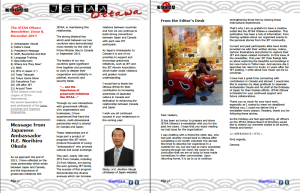Let’s Talk Japan Podcast, Episode 19 – Japanese Translation & Interpretation
Let’s Talk Japan is a monthly, interview format podcast covering a wide range of Japan-related topics. Host Nick Harling (Mie-ken, 2001-03) lived in Japan from 2001 until 2005, including two great years as a JET Program participant in Mie-Ken. He practices law in Washington, D.C., and lives with his wife who patiently listens to him talk about Japan . . . a lot.
In this episode, Nick speaks with Stacy Smith about the joys and challenges of working as a professional Japanese translator and interpreter. Stacy worked as a Coordinator of International Relations (CIR) for the Japan Exchange Teaching (JET) Program in Kumamoto prefecture before eventually returning to the United States and turning her love of Japanese into a career. When not on the road with work, Stacy lives in New York City.
Together they discuss how Stacy became interested in the Japanese language; how she went about deciding to become a professional translator & interpreter; the impact of technology; and tips for improving your own Japanese study habits
To learn more about Stacy, check out her website as well as her blog posts for JETwit. Also, here’s a great article about Japanese translation and interpretation.
If you have not already done so, be sure to “Like” the podcast on Facebook, and follow the podcast on Twitter @letstalkjapan. Additionally, please consider leaving a positive rating and/or review in iTunes.
JETAA Ottawa Newsletter – December 2013
Via JETAA Ottawa. Posted by Gemma Villanueva (Fukushima 2008-11), the past editor for the JETAA Ottawa Newsletter.
The latest digital issue of the JETAA Ottawa Newsletter can be viewed here: http://us4.campaign-archive2.com/?u=4d0d4aa436ad87ff44921adec&id=80f9a73363
What’s in this issue?
Download past issues here:
http://us4.campaignarchive2.com/home/?u=4d0d4aa436ad87ff4492
1adec&id=13d4251245
Let’s Talk Japan, Episode 18 – Aikido
Let’s Talk Japan is a monthly, interview format podcast covering a wide range of Japan-related topics. Host Nick Harling (Mie-ken, 2001-03) lived in Japan from 2001 until 2005, including two great years as a JET Program participant in Mie-Ken. He practices law in Washington, D.C., and lives with his wife who patiently listens to him talk about Japan . . . a lot.
In this episode, I speak with Michael Veltri, the owner and chief instructor at DC Aikido in Washington, DC. Together we discuss the history, philosophy and benefits of Aikido.
Enjoy!
Nick
If you have not already done so, be sure to “Like” the podcast on Facebook, and follow the podcast on Twitter @letstalkjapan. Additionally, please consider leaving a positive rating and/or review in iTunes.
JQ Magazine: The Steady Riser – A Conversation with Tokyo Musician Nelson Babin-Coy

“The Japanese market is a very unique market; it’s very closed. It is kind of frustrating when I try to introduce Western ideals in my music or introduce how I feel live music should be enjoyed at gigs or live venues. If you want to dance, dance. If you want to move, move.” (Lisa (paint with stars) www.paintwithstars.com)
By Sheila Burt (Toyama-ken, 20010-12) for JQ magazine. Sheila recently returned to America after living in Japan for three years (two years in Namerikawa with JET and one year at a private school in Ehime-ken). She is currently looking for a job and welcomes all leads. View more of her work at www.sheilaburt.com.
The first time Tokyo-based musician Nelson Babin-Coy visited Japan, he was a 15-year-old high school student from the suburbs of L.A. who knew next to nothing about Japan. Interested in learning more about Japanese music during his stay in Gunma Prefecture, he started listening to what other teenagers his age were into, including the idol group Morning Musume. Yet when he first heard one of the band’s songs, he cringed a bit. “I wasn’t disgusted, but I was like, ‘This is music in Japan?’,” he laughs.
Thankfully, his host sister introduced him to the Battle Royale theme song by Dragon Ash, and he was hooked. The two weeks Babin-Coy spent in Gunma were enough to give him a new dream to follow. He wanted to live in Japan, though he had yet to figure out the how and what to do.
“I love Japanese music and lyrics,” he says. “I think Japanese artists are more artistic in the way they form their stories.”
Now 28, Babin-Coy is a rising singer-songwriter who primarily sings in Japanese and works with several native artists trying to break into the Western market. He has toured the mainland three times with his band, nothing ever lasts (currently on hiatus).
JQ Magazine: JQ&A with Manga Translator Zack Davisson on Shigeru Mizuki
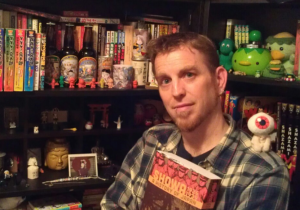
“All of JET is fond memories for me. I loved it. Kansai was the perfect area. Nara, Osaka, and Kyoto were all in easy reach so I had the best of everything. I lived in ancient and traditional Japan, but had wild and modern Japan nearby anytime I wanted. I did everything I could possibly do, went everywhere, tried everything—it changed my life.” (Courtesy of Zack Davisson)
By Julio Perez Jr. (Kyoto-shi, 2011-13) for JQ magazine. A bibliophile, writer, translator, and graduate from Columbia University, Julio is currently seeking opportunities with publications in New York. You can follow his enthusiasm for Japan, literature, and board gaming on Twitter @brittlejules.
A scholar, author and translator of Japanese folklore and ghost stories, Zack Davisson (Nara-ken, 2001-04; Osaka-shi, 2004-06) joined the JET Program in 2001 with some basic Japanese knowledge and a strong desire to learn much more. After spending five years on the program, he remained in Japan to acquire a master’s degree in Japanese studies while writing freelance and translating for Osaka University.
The theme of Japanese ghosts running through Davisson’s writing and translation dovetails the interests of manga legend Shigeru Mizuki, who is famous for the classic series GeGeGe no Kitaro. Mizuki is equally well known in Japan for his autobiographical works about his experiences as a soldier during World War II. A great fan of Mizuki, Davisson now contributes to publisher Drawn and Quarterly’s English adaptations of Kitaro and is the translator of the first volume of Mizuki’s historical manga Showa 1926-1939: A History of Japan, released last month in North America.
In this exclusive, expansive interview, Davisson discusses his time on JET, the significance of Mizuki’s supernatural and historical works, and the unique methods and madness of manga translation.
How did you first become interested in learning the Japanese language, and how long have you been studying it? For aspiring translators who are still studying, do you have any advice about textbooks, programs, or techniques?
I actually became interested when I was about 10 years old and my mother took me to see Seven Samurai at a local art theater. I was hooked pretty early—if I you look at my class pictures from that time I am wearing ridiculous Japan t-shirts. I took Japanese in high school when it was offered as a foreign language, but there were only four of us in the class, so it was cancelled—no one was interested in learning Japanese back then. This was the ’80s, so there was no “Cool Japan.” That pretty much ended my language studies for a while.
Decades later when I went on JET, I was useless language-wise. I thought I knew more Japanese than I did, but really just the set phrases and greetings. I was determined to leave JET functionally bilingual, so I just studied as hard as I could from day one, eventually getting my master’s degree in Japan.
My only real advice for people is to go to Japan, and talk and read and practice as much as humanly possible. There is no substitute for immersion and experience. I always say I learned more Japanese at my local bar, the 100 Club, than I did doing my MA. Talk, talk, talk. Read, read, read. Use Japanese as a living language, don’t just study it as an abstract. And, of course, marry a Japanese person. That’s a huge advantage!
When and where were you posted for JET? Could you talk a bit about your time there and what you remember fondly?
I started JET in…I think 2001. Crazy to think it was more than 10 years ago, because it doesn’t feel that way. I was unusual in that I was a 5-year JET that worked in two prefectures. I did three years in Nara and then two years in Osaka. I don’t know if they still allow you to do that. I was one of the first in my prefecture to get that contract extension, and even then there were only two of us allowed to do it.
As for fond memories…all of JET is fond memories for me. I loved it. Kansai was the perfect area. Nara, Osaka, and Kyoto were all in easy reach so I had the best of everything. I lived in ancient and traditional Japan, but had wild and modern Japan nearby anytime I wanted. I did everything I could possibly do, went everywhere, tried everything—it changed my life. And my career; I got started in writing and translating doing articles for my prefectural newsletter, then moved on to publishing magazine articles for Kansai Time Out and Japanzine. And now I have my Shigeru Mizuki translations out and my book, Yurei: The Japanese Ghost, coming next year. I owe all that to JET and the people I met on JET.
In what ways did you become involved in your community?
I wasn’t a big community person, other than I threw myself into every matsuri I could. I was fascinated with Shinto festivals, especially the big, loud, and dangerous ones. Anything fueled with alcohol and adrenaline. I did the Okayama Hadaka Matsuri four times and brought the magic sticks out twice. I carried this massive mikoshi in a little village in Nara every year. In Osaka, I carried these giant, flaming torches in the Taimatsu Matsuri for my town. I loved the primal nature of these matsuri, the physicality and closeness to the gods—it’s something we’ve completely lost in the U.S. In our quest for safety and comfort we’ve lost something intangible. Something Joseph Campbell would have recognized and appreciated.
Other than that, I was a regular at a local bar, the 100 Club in Osaka. A different kind of community, but that was another life changer. I’m still friends with my pals from the 100 Club and we even got matching tattoos. Not quite as sweet as volunteering at the local children’s eikaiwa, but there it is.
JQ Magazine: JQ&A with Marco Lienhard, Artistic Director of Taikoza
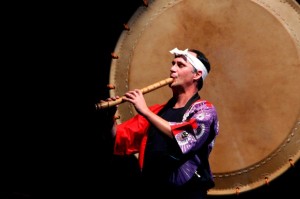
“I always seem to discover new things and different aspects of the music when teaching people from different backgrounds. When trying to explain some of the music, some things seem to come back to mind that were deep inside myself.” (Courtesy of Marco Lienhard)
By Rashaad Jorden (Yamagata-ken, 2008-10) for JQ magazine. A former head of the JETAA Philadelphia Sub-Chapter, Rashaad currently studies responsible tourism management at Leeds Metropolitan University. For more on his life in the UK and enthusiasm for taiko drumming, visit his blog at www.gettingpounded.wordpress.com.
Marco Lienhard has been involved in Japanese music for more than 30 years, first as a member of Ondekoza and then as the artistic director of Taikoza. When building his reputation as a professional taiko player in Japan, Lienhard also mastered the shakuhachi, eventually peforming at four major shakuhachi festivals around the world. He is also the founder of shakuhachi and koto group the East Winds Ensemble.
Lienhard has also released several albums, and his music can he heard on the score of the Nintendo Wii games Red Steel and Red Steel 2. His music has also appeared on ESPN, the History Channel and PBS. In this exclusive interview, Marco discusses his efforts to expand taiko’s global audience, the biggest influences in his career, and his personal highlights among 6,000 performances (and counting).
Where are you originally from and what sparked your interest in Japan and its traditional music?
I originally came from Switzerland, the French part. I went to Japan when I was 18 on some exchange program. I was very interested to go to Japan, but did not know much about it. Once there, I discovered the shakuhachi and the taiko. I had been studying the flute, but that sound of the shakuhachi just was amazing and I decided to study the instrument and master it. The first time I heard it was when I saw Ondekoza. There was taiko, too, and that was just so exciting to see. I did not know that I could play taiko too, but the flute seemed more approachable at the time.
I joined Ondekoza a few months later thinking I would stay just a few months, but it turned into 18 years.
For me, the sound of the shakuhachi was what drew me into it, though I fell in love with the traditional art forms as well. I enjoyed the theater as well as the music. I would go see two to three plays a month, noh or kabuki.
What drew you to taiko in the first place and to become a performer? What are the most important lessons it has taught you?
When I went to Japan, I had been studying piano and flute for many years. To become a performer was just a natural progression from studying with Ondekoza and becoming a member of the group. One thing led to another—studying with them and getting into the whole practice and running aspect of the group.
Marathon running was part of the training, and before long I was running marathons. I joined in August but by November they had me run a full marathon. My first performance was in January for the Imamiya Ebisu Festival on Dotonburi Street in Namba, Osaka. Once I started performing, I got the bug and just wanted to get better at it and study the shakuhachi as well. I was the only one who studied the shakuhachi so I was put on stage very quickly. Taiko has taught me a lot. It is sort of a college or university if not more—a life lesson.
Mr. [Tagayasu] Den, who was the founder of Ondekoza, [influenced] what taiko is now. He was a great influence in the development of modern taiko, though he never really played taiko. He was the brain and the force behind the group. He would lecture us on everything. He would turn a book into lessons for us to learn and apply to stage or performing or taiko. His vision as a director also influenced me on staging of a show
You were a professional taiko player in Japan. How does one become a professional taiko player?
While I was in Japan, I joined Ondekoza and as a member of Ondekoza I studied and later performed professionally with Ondekoza, traveling around the world to perform. At the time, Ondekoza and taiko groups were still not that popular and they did not yet have an apprenticeship system. As a member, you learned the repertoire and practiced with the regular members until you were at their level and were performing among them. It took me about four months before I had my debut on shakuhachi, and taiko drummer Den, the director of Ondekoza, is the person who would decide who was playing and what instrument.
JQ Magazine: JQ&A with Producer Jeron Moore on ‘The Legend of Zelda: Symphony of the Goddesses’
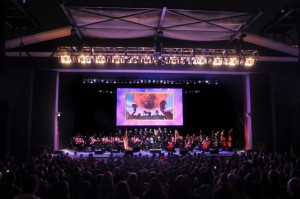
Producer Jeron Moore on Symphony of the Goddesses: “We cater to all ages. You’ve got to remember that Zelda is 27 years old now. We’re seeing fans spanning three generations buying tickets to the show.” (Andrew Craig)
By Vlad Baranenko (Saitama-ken, 2000-02) for JQ magazine. Vlad is an avid photographer.
F. Scott Fitzgerald famously said, “There are no second acts in American lives.”
Fortunately, there are Second Quests.
Over 25 years after the blockbuster Nintendo video game series first hit the scene bearing its namesake in honor of Fitzgerald’s wife, The Legend of Zelda: Symphony of the Goddesses returns for an encore run in some of North America’s most distinguished theater halls (including, for the first time, a pair of dates in Mexico). Presented by Jason Michael Paul Productions, the show—currently on tour through December—presents the very best of Zelda’s lush symphonic scores paired with a live orchestra and visual effects.
In this JQ exclusive, producer and lead creative Jeron Moore sounds off what’s new about the show, the experience of working with Nintendo to bring the ultimate live experience to fans, and the evolution of Link throughout the saga’s rich history.
What was the inspiration for this installment of the show?
Well, if you’re a Zelda aficionado, you’ll recognize the term “Second Quest” from the New Game+ mode from the original 1986 entry, The Legend of Zelda, on the NES. It’s a mode you’d unlock once you defeated the game, and what it did was reorganize the game a little bit, made the dungeons a bit harder, made the items a bit more challenging to find, made the bosses a bit more difficult to defeat. We’ve taken the idea of visiting familiar places while encountering new challenges and applied that to the Second Quest, which has been revamped to include a half hour of new material while keeping all of the classics that make The Legend of Zelda what it is.
What surprises can we expect from the Second Quest?
They wouldn’t be surprises if I told you! But I will hint that we’re celebrating the 20th anniversary of a particular, very special handheld title. We’ve also finally included some music from one of the most recent Zelda games, which we steered cleared of with the first season program. And at the request of Mr. Eiji Aonuma, you can also expect to see a fully revamped Wind Waker segment, featuring gorgeous visuals from the game’s recent HD release on the Wii U. The Wind Waker has never looked better.
How did the idea for format of the show come about? The large screen, the orchestra?
It’s simple. There’s just nothing classier than a large orchestra tuning up, then performing powerhouse symphonic interpretations of your favorite music, no matter the genre. For The Legend of Zelda, we wanted Symphony of the Goddesses to be as accessible as possible. There’s nothing worse than sitting in a room and feeling left behind because you didn’t walk in with a prerequisite knowledge of the material. The music undoubtedly stands on its own, but incorporating visuals opens it up and informs the entire audience of context, not just those who’ve played the games before. Of course, being the fans that we are, we’ve carefully edited the footage into an entertaining narrative that, we feel, makes sense. With that, we’re able to hit on many of the important moments universally adored by fans, so yeah—lots of inside jokes, but we try not to let anything fall flat.
JQ Magazine: JQ&A with Tom Byer on Life in Soccer, Japan

“I believe we may see Japan win a World Cup within my lifetime, and I certainly think they will be the first Asian team to do so. They are the type of team that the current world powers would not like to have in their group during a WC tournament.” (Courtesy of K.K. T3)
By Lyle Sylvander (Yokohama-shi, 2001-02) for JQ magazine. Lyle has completed a master’s program at the School of International and Public Affairs at Columbia University and has been writing for the JET Alumni Association of New York since 2004. He is also the goalkeeper for FC Japan, a New York City-based soccer team.
Tom Byer (a.k.a. Tomsan) is an American soccer coach who has lived in Japan for nearly 30 years. The first professional American soccer player in Asia, he has been a major figure in Japan as a coach and educator. In fact, many people in Japan see him as a major catalyst behind the country’s rising status as a global soccer power. Byer is responsible for increasing soccer’s popularity and teaching fundamental skills to hundreds of thousands of children, including many of the nation’s most celebrated players. In the process, he has become a well-known media personality and has even extended his influence to China, where he signed a contract with the Chinese Football Association to be a technical director for youth teams.
Where are you from? Was soccer popular there when you were growing up?
I was born in the Bronx, New York City. I grew up in Rosendale, Ulster County, Upstate New York. Soccer was just becoming popular when I was a kid. I first started playing baseball and changed over to soccer after my brother and his friends started to play. But soccer was still a very minor sport.
How did you end up living and working in Japan?
I was introduced to Hitachi FC, which is currently playing in the J-League as Kashiwa Reysol, back in 1986 because my college coach at Ulster County Community College had some connections here. So I had a short stint with them, which gave me experience in Japanese soccer. And when I hung up the playing boots I decided to get into youth development. I also did many things on the U.S. military bases for kids playing soccer.
Can you tell us about your company T3, which aims to educate Japanese schoolchildren about soccer?
My company is called T3—the T stands for “Tom” and the 3 for “san,” Tomsan, because I am known by Tom-san throughout Japan from my appearances on daily television for 13 years. The name of the TV corner was, “Tom-san’s Soccer Techniques.” We try to help every child we come in contact with to “realize their potential.” We are technical specialists helping kids, coaches and parents understand the importance of developing technique. I have performed over 2,000 events for more than 500,000 people over the years. I established another company which I headed up for 16 years which established over 100 soccer schools throughout Japan. It’s difficult to find almost any player in Japan today who hasn’t been influenced in some way regarding our activities. This means either they’ve grown up watching my daily TV corner, read the monthly KoroKoro Komikku manga, or have played in one of our 100 schools, camps, or bought our DVDs or books.
Let’s Talk Japan Podcast, Episode 15 – JET Alumni Bike Shikoku’s 88 Temple Pilgrimage
Let’s Talk Japan is a monthly, interview format podcast covering a wide range of Japan-related topics. Host Nick Harling (Mie-ken, 2001-03) lived in Japan from 2001 until 2005, including two great years as a JET Program participant in Mie-Ken. He practices law in Washington, D.C., and lives with his wife who patiently listens to him talk about Japan . . . a lot.
In this episode, Nick speaks with JET Program alumni Chelsea Reidy and Elayna Snyder about their upcoming 900-mile bicycle tour of Shikoku’s famous 88 temple pilgrimage.
Listen to hear them describe their creative “Temple by Temple Project,” which they are funding through Kickstarter, and how they plan to share their adventure with others.
To learn more, check out their website, www.bigricefield.com, and the Temple by Temple Project on Kickstarter.
Enjoy!
Nick
Books: An English Language Guide to Crafting in Tokyo
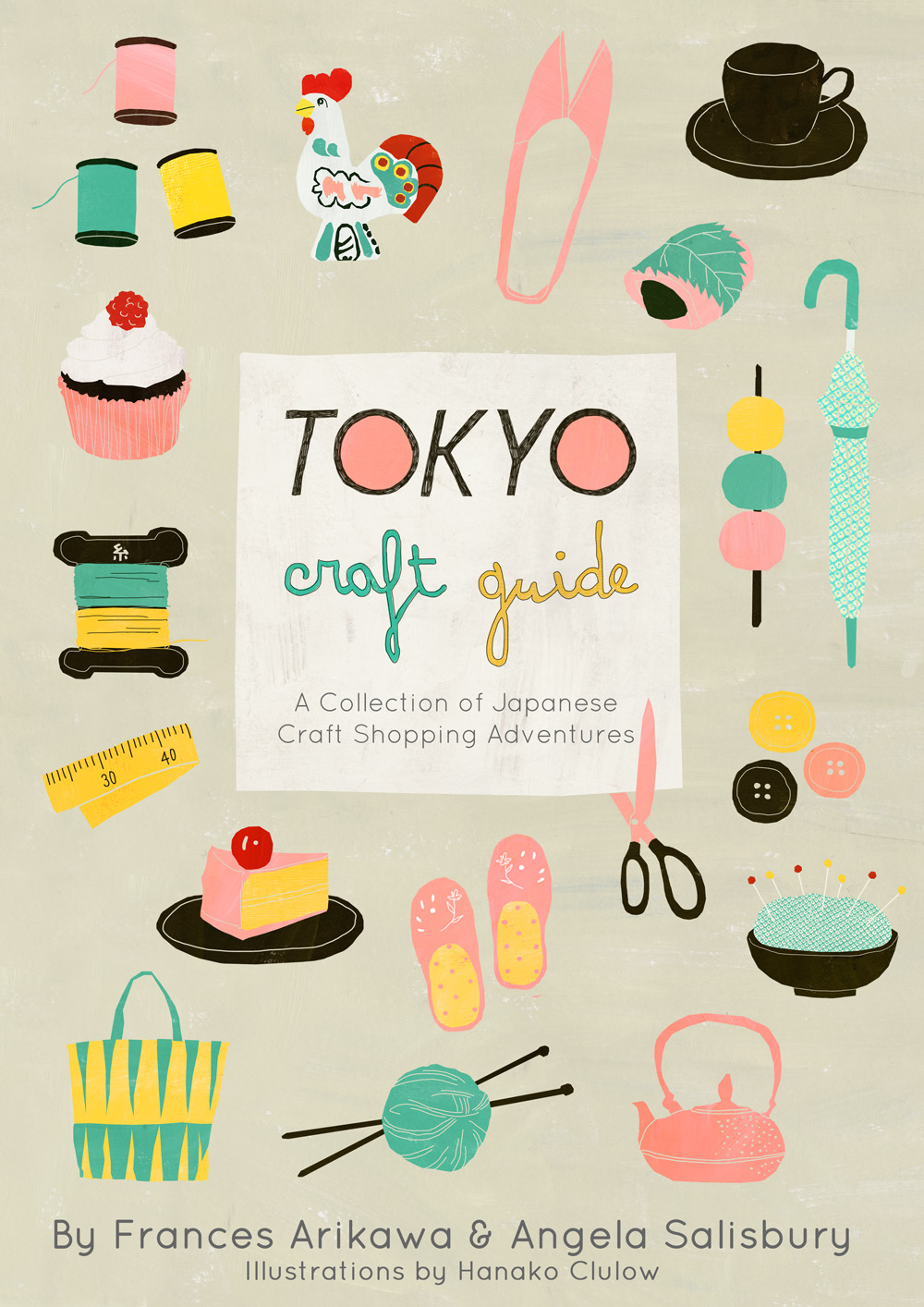 Interview by Rose Symotiuk (Hokkaido 2003-2005) with Angela Salisbury, author of the Tokyo Craft Guide:
Interview by Rose Symotiuk (Hokkaido 2003-2005) with Angela Salisbury, author of the Tokyo Craft Guide:
As a JET, I keep track of my friends from my Japan days on Facebook. I started seeing posts by my fellow JETs for this cool e-book about crafting in Tokyo. Imagine my surprise when I realized that one of the authors, Angela Salisbury, was an old friend from high school!
I reached out to her to find out more about the book, crafting in Japan, and the JET crafting scene….
Rose: So, how long have you lived in Japan?
Angela: 3 years
Rose: Why did you move to Japan?
Angela: Adventure! The real answer? My husband’s job needed him in Asia, and we decided Tokyo was the place for us.
Rose: Is there an expat crafting scene in Tokyo? If so, can you tell me a little bit about it? Read More
JQ Magazine: COBU Gives Sakura Matsuri Season a Beat

Takae Kawabe, a member of the all-female New York City-based taiko group COBU. (Courtesy of Takae Kawabe)
By Kirsten Phillips (Niigata-ken, 2005-2008) for JQ magazine. Kirsten is a native New Yorker and currently works as a teacher for the New York Board of Education.
Sakura matsuri season is upon us. For JET returnees, this time of year hearkens back to picnics with friends or students. Copious amounts of alcohol under the pink shower of blossoms and maneuvering through crowded lines of vendors celebrating the coming of spring. Sakura season also brings out the finest Japanese talent in New York and no event worth mentioning would be whole without the beating heart of COBU.
You haven’t been following COBU around like a bloodhound? Shame on you. Don’t even know what a COBU is? Double shame on you. Fortunately, oneesan is here to clue you in.
Spearheaded by artist and visionary Yako Miyamoto, COBU is more of a statement in taiko than a collaboration. We are heard. We are seen. We are felt. We are here. A handful of iron women play tirelessly in perfect sync. A little humor, an appropriate smattering of sexy and a metric ton of showmanship make COBU a delight for audiences across the tri-state area.
This year’s Branch Brook Park performance in New Jersey was a staggering hit by COBU, showcasing the talent of their following, or deshi. Upstage, COBU performing members Micro Fukuyama and Haruna Hisada kept time and loudly cheered on the fledgling members as they demonstrated some of COBU’S trademark choreography and pulsing patterns. If you have ever witnessed a COBU show before, it’s easy to become dazzled by the performing members, but this showcase invited audiences to the notion that, hey, they can be a part of this rhythm, too.
Let’s Talk Japan Podcast, Episode 10 – Smile Kids Japan
Let’s Talk Japan is a twice monthly, interview format podcast covering a wide range of Japan-related topics. Host Nick Harling (Mie-ken, 2001-03) lived in Japan from 2001 until 2005, including two great years as a JET Program participant in Mie-Ken. He practices law in Washington, D.C., and lives with his wife who patiently listens to him talk about Japan . . . a lot.
Dear JETs and JET Alumni,
One of the main reasons I started the Let’s Talk Japan podcast was to highlight the positive impact JETs and JET alumni have on their local communities in Japan. In Episode 10, I interviewed Meredith Smith, Media and Public Relations Director for Smile Kids Japan, a volunteer organization founded by JETs in Fukui Prefecture which encourages visits to orphanages in Japan. Through its website and volunteer leadership, Smile Kids Japan helps facilitate such visits by serving as a resource for best practices. This organization is doing amazing work, and I hope this episode helps raise its profile both in Japan and abroad.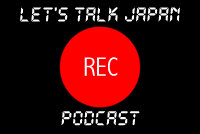
Enjoy!
Nick
If you have not already done so, be sure to “Like” the podcast on Facebook, and follow the podcast on Twitter @letstalkjapan. Additionally, please consider leaving a positive rating and/or review in iTunes.
JET alum Lucia Brea interviewed by NY Public Library Blog about JET Program
The New York Public Library Blog recently interviewed JET alum Lucia Brea (Fukui-ken) about her experience on the JET Program:
STUFF FOR THE TEEN AGE, THE TICKETLESS TRAVELER
Think Japan is all Manga, Sushi, and Pocky Sticks?
by Rabecca Hoffman, Kingsbridge Library
March 21, 2013
Harajuku? Geisha? Robots? Awesome! Japanese culture has been an obsession of mine for a while now, as well as for the teenagers at my branch, so when we recently had the opportunity to invite Lucia Brea, Fukui Friendship Ambassador, to stop by and talk to the Kingsbridge Library’s Teen Advisory Group, I jumped at the opportunity. Lucia spent four years in Japan through the JET Program teaching English to students of all ages in the Fukui Prefecture, and I was able to sit down with her after her visit to ask her a few questions about her experience:
What is the JET program, and would you recommend it for other people? Are there other ways to go about living in Japan as a foreigner?
The JET Programme stands for Japan Exchange and Teaching Programme, now in its 26th year, which aims to promote grass-roots international exchange between Japan and other countries. I would highly recommend it to anyone who has a passion for developing strong relationships with communities and the drive to live in Japan for an extended period of time. It is an opportunity to experience Japan and continue to enhance relationships between Japan and their home country like I did at the New York Public Library. There are many other ways to live in Japan as a foreigner, the JET Programme is one of the best…
CLICK HERE to read the full article on the New York Public Library site.
JQ Magazine: JQ&A with JUSTE Program Participant Saiko Goto
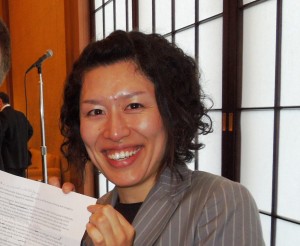
“In Minamisanriku, the local government wanted to keep the shiyakusho (city hall) as a memorial for the tsunami, but people who lost family there disagreed. Finally, the building was demolished recently. It reminded us of sad stories and memories of people who escaped to city hall during the tsunami.” (Courtesy of Saiko Goto)
By Fernando Rojas (Fukui-ken, 2008-10) for JQ magazine. A resident of Teaneck, New Jersey, Fernando was JHS ALT in Fukui prefecture, home of the echizen-gani, a city named Obama, the Fukuisaurus, and nuclear power plants. While in Japan, he picked up shuji (Japanese calligraphy) as his hobby and continues to practice today. He is currently a fellowships associate for the Social Science Research Council’s Abe Fellowship Program in Brooklyn and co-representative for the JETAA New Jersey subchapter.
Hailing from Tome City in Miyagi Prefecture, Saiko Goto was a recent JUSTE Program participant at Rutgers University in New Jersey. Informally called the “Reverse JET Program,” the Japan–U.S. Training and Exchange Program for Language Teachers allows Japanese Teachers of English (JTEs) from all over Japan to take courses in ESL teaching at U.S. universities.
Goto received her teaching license from Gunma Prefecture Women’s University, where she majored in English. She currently teaches at Sakuma Junior High School and has taught English for eight years. Before returning to Japan in January, Goto spoke with JQ about JUSTE and the ongoing impact of the March 11 earthquake and tsunami on her school.
How are teachers selected to participate in the JUSTE program?
Teachers are selected according to their prefectures. In some prefectures, teachers have to apply for the program. In other prefectures, teachers are picked by the board of education. In my case, I was recommended by my principal to the Tome City Board of Education and selected by the Miyagi Prefecture Board of Education.
Have you found the JUSTE program beneficial? In what ways has the program helped you?
Being on JUSTE has been very beneficial. I have met and talked with many people from different countries, as well as learned a lot from them through English. I have also thought more about my teaching and the importance of learning English. The program has also helped me to create more effective activities. I made many activities with other JUSTE members and we will use them in my classes.
Would you recommend the program to other JTEs in Japan?
Definitely. By participating in the program, you can have many chances for meeting people and learn a lot. I visited a former ALT during the winter vacation and experienced life in Arkansas with her and her family. I also became friends with other JUSTE participants. We will share our list of activities with each other online and keep in touch.
JQ Magazine: JQ&A with Bruce Feiler on ‘The Secrets of Happy Families’
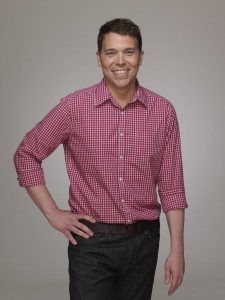
“One big idea in my book is that families should adapt all the time. The single best thing we’ve done is to add a weekly family meeting. We ask three questions, based on a popular program called ‘agile families.’ And no surprise: that idea was born in Japan in the culture of real-time change.” (Courtesy of HarperCollins Publishers)
By Sharona Moskowitz (Fukuoka-ken, 2000-01) for JQ magazine. Sharona is interested in fresh, new voices in fiction and creative nonfiction.
New York Times bestselling author and columnist Bruce Feiler (Tochigi-ken, 1987-88) has written a range of books dealing with topics as varied as life in Japan (depicted in 1991’s Learning to Bow), religion, and his own diagnosis with cancer.
His latest book, The Secrets of Happy Families, is a playbook for today’s family with tips and advice for increasing overall happiness and strengthening the family unit. Unlike other family-related books, Feiler does not advocate one particular method or philosophy over another; rather, he has done a thorough investigation of what happy families have in common and offers readers a slice of the pie.
In this exclusive interview, Feiler shares how his experience in Japan has given him insight into family life across cultures, as well as his take on the modern family’s trials and tribulations.
It seems the book market is already glutted with all sorts of self-help books about families. What sets your book apart and why do you feel that it is particularly timely?
In many ways, I was motivated by the deluge of self-help books. They’re boring, tried, and out of fresh ideas. As a parent, I was completely frustrated and had tons of questions about how to make my family function more effectively, and the only books out there were from “family experts.” Meanwhile, in every other arena of contemporary life—from Silicon Valley to elite peace negotiators, from championship sports teams to the Green Berets—there are proven new ways to make teams and groups run more smoothly. I wanted to know what those people were doing with their own families, then test their ideas with mine. Not every idea worked. That’s why I put over 200 new ones in the book, because what clicks with your family may be different from what clicked with mine. But my hope is that if you take three ideas, you’ll have a happier family in a week.
In the chapter about the agile manifesto, you talk about the importance of “being part of the family team.” In writing about the importance of teamwork within the family, were you inspired at all by your experience in Japan, a culture which valorizes the group above all else?
I think it may be more the other way around, in that I was attracted to Japan because I’ve always been interested in tight groups and well-run teams. At the time I lived in Japan, in the late 1980s, Americans still believed that the individual mattered above all else. But one thing we’ve learned from the Internet is that we all have a natural inclination toward groups, social networks, and other gatherings of people. The first generation of happiness research has shown us that relationships matter above all else. Happiness is other people. And the people who matter most to us are our family. Yet there have been almost no books that tell us how to do that.
Are there other cultural practices you observed in your time in Japan which you believe could benefit American families?
One I learned while in Japan is that being part of a group doesn’t just happen. Japanese schools, in particular, work on it. I remember a school trip I went on where classes were divided into small groups. The number one rule was, don’t be late. The number two rule was, only one person in each group was allowed to have a watch. Guess what! You better stick together. Having a close family doesn’t just happen, either—you have to work on it. Fortunately, there are lots of new ideas out there to do that, which I’ve tried to gather.

